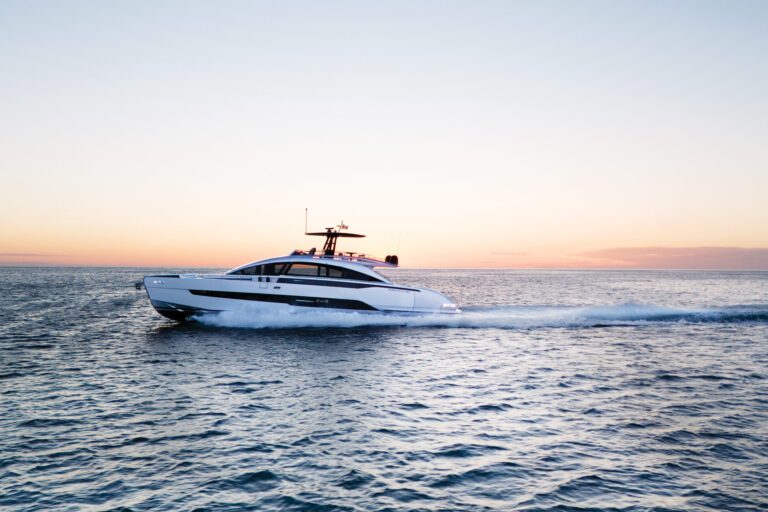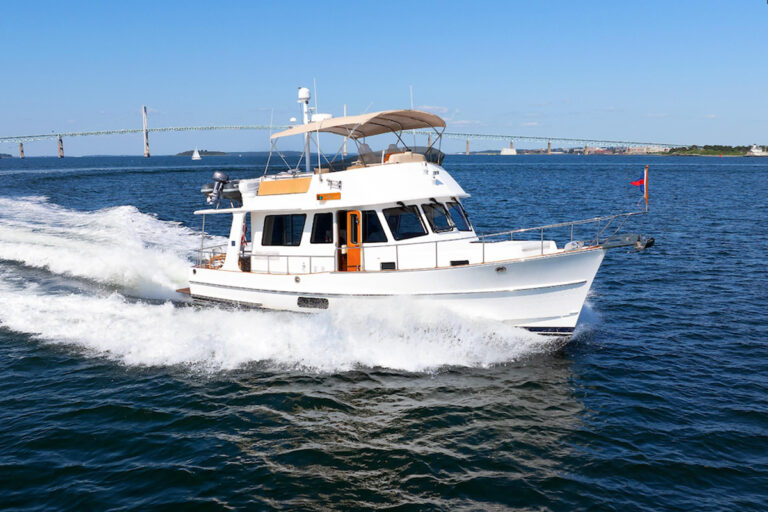I am a nut for British design, but I must admit that at first my relationship with it was love-hate. My first car, a 1958 Austin Healey “bug-eye” Sprite, was a delight to drive but was seldom up to the challenge. Since the Beatles, it seems British stuff has continued to get better. Today, it is often second to none. For one, there’s my new Land Rover, which, like most things British, is quite distinct and a pleasure to drive. For another, there’s Fairline’s Squadron 62.
Fairline Boats builds the Squadron 62 in Oundle, England. The company began building boats 34 years ago and, at the start, focused on the local river cruiser market. In the 1970s, Fairline took aim at the blossoming international market. Today, the company has three boat lines: Targa (30- to 48-foot express cruisers), Phantom (38- to 50-foot cruisers) and Squadron (52- to 65-foot motoryachts).
The 62 is an excellent example of the mark. Her styling is a product of the “European school” that has become popular in the United States in recent years. Her superstructure lines flow aft in a combination of smooth, curved surfaces and are accented by sleek window lines. Side decks, which extend from her afterdeck to her foredeck, are a feature some misguided American designers have deemed unnecessary. A hearty stainless-steel handrail borders the foredeck and flares outboard, following the topsides. This is fairly common in European design, but it leaves the rail an uncomfortable reach.
Handlaid teak decks are an option and extend from the bow to the integral swim platform. The afterdeck has curved seating and is fitted with warping windlasses that will be of particular benefit to cruising couples when docking. A hydraulically operated passarelle, for docking stern-to, tucks neatly into the transom.
A staircase leads from the afterdeck to the flying bridge. There is also interior access adjacent to the raised pilothouse area. The flying bridge has a helm station with three seats, a sunning area forward and a circular seating area aft. A table is suited for cocktails or dining, and a bar area is fitted with a sink, a refrigerator and an electric barbecue grill.
Stainless steel frames the sliding glass door that leads from the afterdeck to the circular seating area in the saloon. An entertainment center is designed to accommodate a TV and stereo system, and a wet bar can be fitted with a refrigerator or ice maker. The sole is raised forward of this area, with a dinette to port and a helm station with two electrically adjustable seats and a tilt wheel on centerline. A standard electronics package includes autopilot, GPS/chart plotter and radar.
The galley is just ahead of the helm, several steps down to port. It has a four-burner cooktop, a microwave/convection oven and a dishwasher. There is custom stowage for silverware, china and glassware. Though a bit small by American standards, the galley is adequate and thoughtfully laid out, right down to the cleverly designed pullout pantry. A door and entry foyer to starboard allow the helmsman convenient access to the main deck, and provisioning can be accomplished without wandering through the saloon.
A staircase from the entry foyer leads belowdecks. The full-beam master suite forward of the engineroom has a berth that is roughly king-size, a full-size wardrobe and an entertainment center with TV. Frosted glass double doors separate the sleeping area from the master head, which has a large stall shower. A guest stateroom, to port, has two single berths. A head with stall shower is accessible from the passageway and serves as a day head. A VIP stateroom, forward, has an island berth and stall shower. A ship’s laundry area with a washer/dryer is accessible from the passageway.
A crew’s cabin with two berths and a head is abaft the machinery space and accessible from the afterdeck. The crew’s cabin is an option, and many Americans likely will use the space for stowage. It is also the sensible spot for serious cruisers to incorporate additional freezer space.
Those not familiar with Fairline’s products will be impressed with the 62’s interior detail. The lacquer-finished American cherry is accented with eucalyptus burl and is flawlessly executed and complemented by high-end hardware and soft goods. The 62’s exterior and interior layouts are also unique, which is a compliment to her design team. Some designers cannot extricate themselves from “Euro-style,” but this is not the case at Fairline.
Following my sea trial, I discussed Fairline’s approach to design with Adam Greenwood, the company’s technical manager. I was impressed with several aspects of the design and construction process.
First, designers are grouped in product-specific teams. On the 62, for example, a team of designers is responsible for any updates during production, and for the development of future models in the Squadron line. Fairline’s craftsmen use the same approach during construction.
“We feel that our team method of design and construction instills pride in our craftsmen and creates a more consistent product,” Greenwood said. He’s right, based on the Fairline products I’ve inspected.
The 62’s hull and superstructure are built in female tooling. Gelcoat is brushed by hand, and the laminate is a combination of handlaid chopped strand mat, stitched unidirectional and woven roving reinforcements. A network of fiberglass stringers and web frames support the bottom, together with marine plywood structural bulkheads that are fiberglassed in place.
The hull sides and bottom are solid fiberglass, and the superstructure and decks are cored with closed cell foam that is hand-applied to the laminate. The hull-deck joint is bonded and mechanically fastened. In all, a relatively conservative approach to design.
A hatch in the afterdeck sole leads to the machinery space. Access is reasonable, but the saloon sole is removable, should the need arise. Fairline follows a detailed checklist during design and production to ensure proper access for service.
Fuel is carried in two 495.5-gallon aluminum tanks, and a distribution manifold allows each engine to draw from and return to either tank. Water is carried in two 132.5-gallon fiberglass tanks. Fairline boats shipped to the United States are equipped with 220/110/60 Hz-volt AC and 24-volt DC electrical systems, and bonding systems are installed as per American Boat & Yacht Council standards.
The 62 is priced at $1,692,000 with a pair of 800 hp Caterpillar 3406 diesels. The cost includes virtually everything from electronics to salad forks, but the Achilles’ heel of foreign builders pursuing the American market has always been service after the sale. Fairline has 35 dealers around the world and seems committed to raising the bar. The beautifully detailed owner’s manuals, for example, are the finest I have seen in the marine industry. Marina One, the South Florida dealer whose boat I tested, was intimately familiar with the product and has a world-class facility to support it.
Yes, the British have arrived. This time, it seems they’re here to stay.
Contact: Fairline Boats of North America, (843) 342-3453; fax (843) 342-3483; www.fairline.com.





